2006 MERCEDES-BENZ SPRINTER air condition
[x] Cancel search: air conditionPage 1050 of 2305
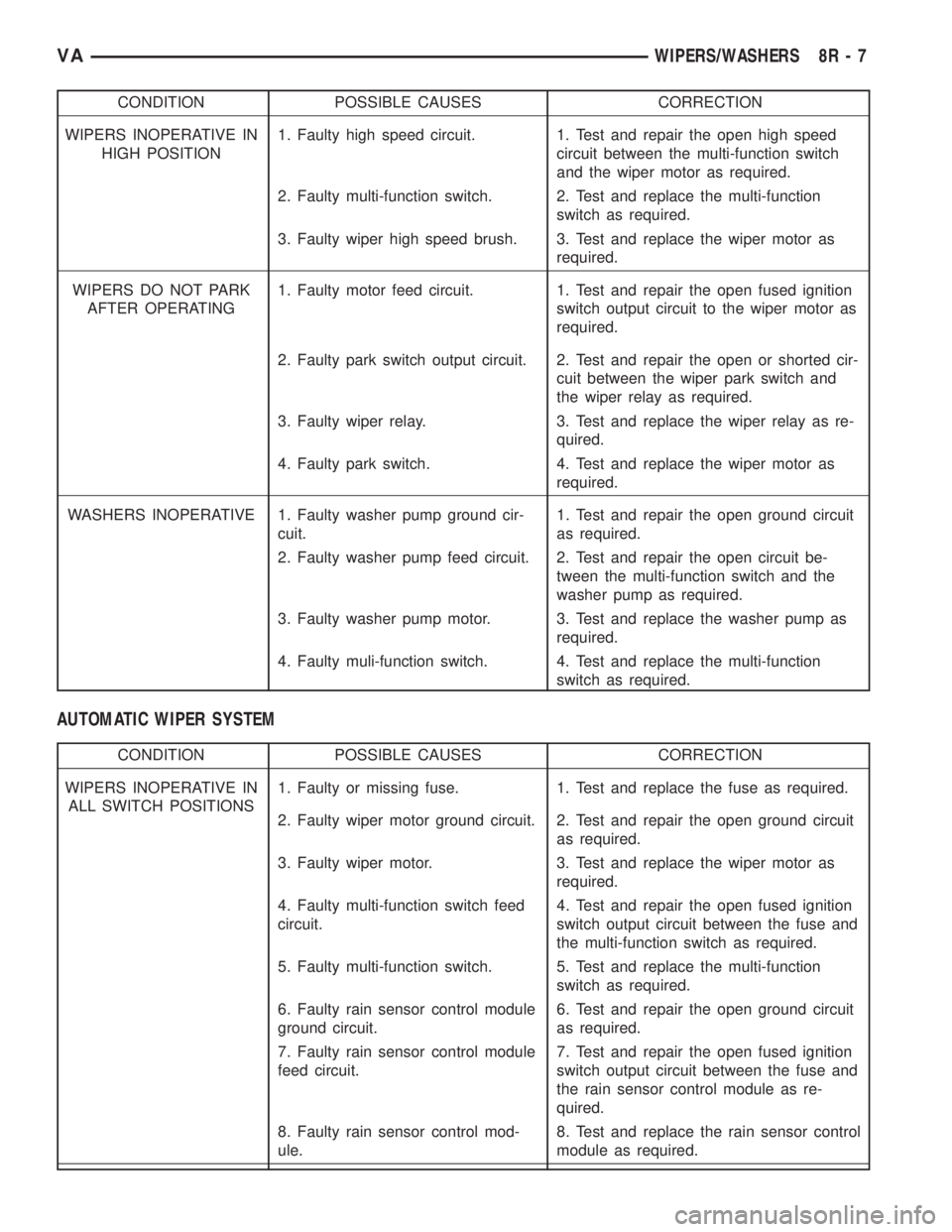
CONDITION POSSIBLE CAUSES CORRECTION
WIPERS INOPERATIVE IN
HIGH POSITION1. Faulty high speed circuit. 1. Test and repair the open high speed
circuit between the multi-function switch
and the wiper motor as required.
2. Faulty multi-function switch. 2. Test and replace the multi-function
switch as required.
3. Faulty wiper high speed brush. 3. Test and replace the wiper motor as
required.
WIPERS DO NOT PARK
AFTER OPERATING1. Faulty motor feed circuit. 1. Test and repair the open fused ignition
switch output circuit to the wiper motor as
required.
2. Faulty park switch output circuit. 2. Test and repair the open or shorted cir-
cuit between the wiper park switch and
the wiper relay as required.
3. Faulty wiper relay. 3. Test and replace the wiper relay as re-
quired.
4. Faulty park switch. 4. Test and replace the wiper motor as
required.
WASHERS INOPERATIVE 1. Faulty washer pump ground cir-
cuit.1. Test and repair the open ground circuit
as required.
2. Faulty washer pump feed circuit. 2. Test and repair the open circuit be-
tween the multi-function switch and the
washer pump as required.
3. Faulty washer pump motor. 3. Test and replace the washer pump as
required.
4. Faulty muli-function switch. 4. Test and replace the multi-function
switch as required.
AUTOMATIC WIPER SYSTEM
CONDITION POSSIBLE CAUSES CORRECTION
WIPERS INOPERATIVE IN
ALL SWITCH POSITIONS1. Faulty or missing fuse. 1. Test and replace the fuse as required.
2. Faulty wiper motor ground circuit. 2. Test and repair the open ground circuit
as required.
3. Faulty wiper motor. 3. Test and replace the wiper motor as
required.
4. Faulty multi-function switch feed
circuit.4. Test and repair the open fused ignition
switch output circuit between the fuse and
the multi-function switch as required.
5. Faulty multi-function switch. 5. Test and replace the multi-function
switch as required.
6. Faulty rain sensor control module
ground circuit.6. Test and repair the open ground circuit
as required.
7. Faulty rain sensor control module
feed circuit.7. Test and repair the open fused ignition
switch output circuit between the fuse and
the rain sensor control module as re-
quired.
8. Faulty rain sensor control mod-
ule.8. Test and replace the rain sensor control
module as required.
VAWIPERS/WASHERS 8R - 7
Page 1051 of 2305
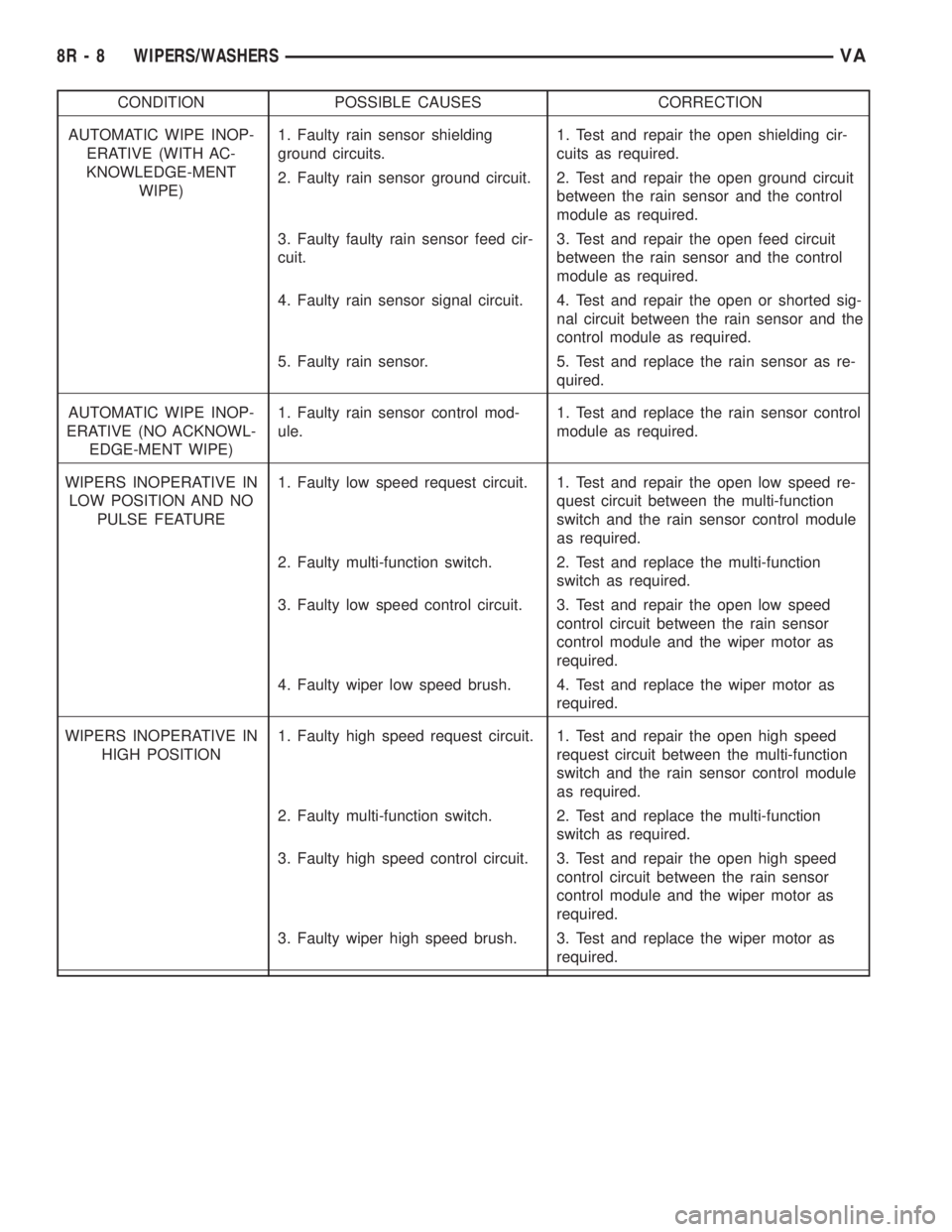
CONDITION POSSIBLE CAUSES CORRECTION
AUTOMATIC WIPE INOP-
ERATIVE (WITH AC-
KNOWLEDGE-MENT
WIPE)1. Faulty rain sensor shielding
ground circuits.1. Test and repair the open shielding cir-
cuits as required.
2. Faulty rain sensor ground circuit. 2. Test and repair the open ground circuit
between the rain sensor and the control
module as required.
3. Faulty faulty rain sensor feed cir-
cuit.3. Test and repair the open feed circuit
between the rain sensor and the control
module as required.
4. Faulty rain sensor signal circuit. 4. Test and repair the open or shorted sig-
nal circuit between the rain sensor and the
control module as required.
5. Faulty rain sensor. 5. Test and replace the rain sensor as re-
quired.
AUTOMATIC WIPE INOP-
ERATIVE (NO ACKNOWL-
EDGE-MENT WIPE)1. Faulty rain sensor control mod-
ule.1. Test and replace the rain sensor control
module as required.
WIPERS INOPERATIVE IN
LOW POSITION AND NO
PULSE FEATURE1. Faulty low speed request circuit. 1. Test and repair the open low speed re-
quest circuit between the multi-function
switch and the rain sensor control module
as required.
2. Faulty multi-function switch. 2. Test and replace the multi-function
switch as required.
3. Faulty low speed control circuit. 3. Test and repair the open low speed
control circuit between the rain sensor
control module and the wiper motor as
required.
4. Faulty wiper low speed brush. 4. Test and replace the wiper motor as
required.
WIPERS INOPERATIVE IN
HIGH POSITION1. Faulty high speed request circuit. 1. Test and repair the open high speed
request circuit between the multi-function
switch and the rain sensor control module
as required.
2. Faulty multi-function switch. 2. Test and replace the multi-function
switch as required.
3. Faulty high speed control circuit. 3. Test and repair the open high speed
control circuit between the rain sensor
control module and the wiper motor as
required.
3. Faulty wiper high speed brush. 3. Test and replace the wiper motor as
required.
8R - 8 WIPERS/WASHERSVA
Page 1052 of 2305
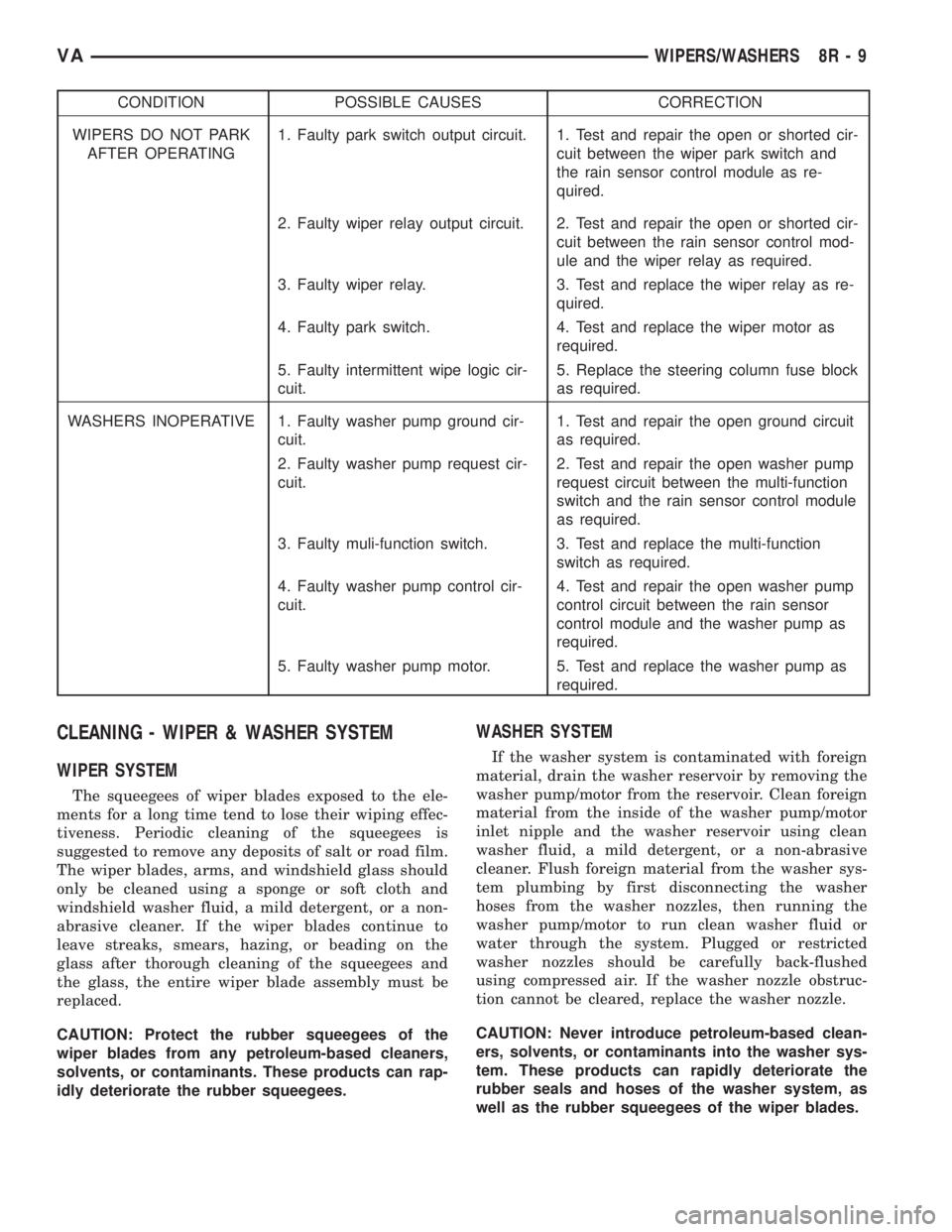
CONDITION POSSIBLE CAUSES CORRECTION
WIPERS DO NOT PARK
AFTER OPERATING1. Faulty park switch output circuit. 1. Test and repair the open or shorted cir-
cuit between the wiper park switch and
the rain sensor control module as re-
quired.
2. Faulty wiper relay output circuit. 2. Test and repair the open or shorted cir-
cuit between the rain sensor control mod-
ule and the wiper relay as required.
3. Faulty wiper relay. 3. Test and replace the wiper relay as re-
quired.
4. Faulty park switch. 4. Test and replace the wiper motor as
required.
5. Faulty intermittent wipe logic cir-
cuit.5. Replace the steering column fuse block
as required.
WASHERS INOPERATIVE 1. Faulty washer pump ground cir-
cuit.1. Test and repair the open ground circuit
as required.
2. Faulty washer pump request cir-
cuit.2. Test and repair the open washer pump
request circuit between the multi-function
switch and the rain sensor control module
as required.
3. Faulty muli-function switch. 3. Test and replace the multi-function
switch as required.
4. Faulty washer pump control cir-
cuit.4. Test and repair the open washer pump
control circuit between the rain sensor
control module and the washer pump as
required.
5. Faulty washer pump motor. 5. Test and replace the washer pump as
required.
CLEANING - WIPER & WASHER SYSTEM
WIPER SYSTEM
The squeegees of wiper blades exposed to the ele-
ments for a long time tend to lose their wiping effec-
tiveness. Periodic cleaning of the squeegees is
suggested to remove any deposits of salt or road film.
The wiper blades, arms, and windshield glass should
only be cleaned using a sponge or soft cloth and
windshield washer fluid, a mild detergent, or a non-
abrasive cleaner. If the wiper blades continue to
leave streaks, smears, hazing, or beading on the
glass after thorough cleaning of the squeegees and
the glass, the entire wiper blade assembly must be
replaced.
CAUTION: Protect the rubber squeegees of the
wiper blades from any petroleum-based cleaners,
solvents, or contaminants. These products can rap-
idly deteriorate the rubber squeegees.
WASHER SYSTEM
If the washer system is contaminated with foreign
material, drain the washer reservoir by removing the
washer pump/motor from the reservoir. Clean foreign
material from the inside of the washer pump/motor
inlet nipple and the washer reservoir using clean
washer fluid, a mild detergent, or a non-abrasive
cleaner. Flush foreign material from the washer sys-
tem plumbing by first disconnecting the washer
hoses from the washer nozzles, then running the
washer pump/motor to run clean washer fluid or
water through the system. Plugged or restricted
washer nozzles should be carefully back-flushed
using compressed air. If the washer nozzle obstruc-
tion cannot be cleared, replace the washer nozzle.
CAUTION: Never introduce petroleum-based clean-
ers, solvents, or contaminants into the washer sys-
tem. These products can rapidly deteriorate the
rubber seals and hoses of the washer system, as
well as the rubber squeegees of the wiper blades.
VAWIPERS/WASHERS 8R - 9
Page 1054 of 2305
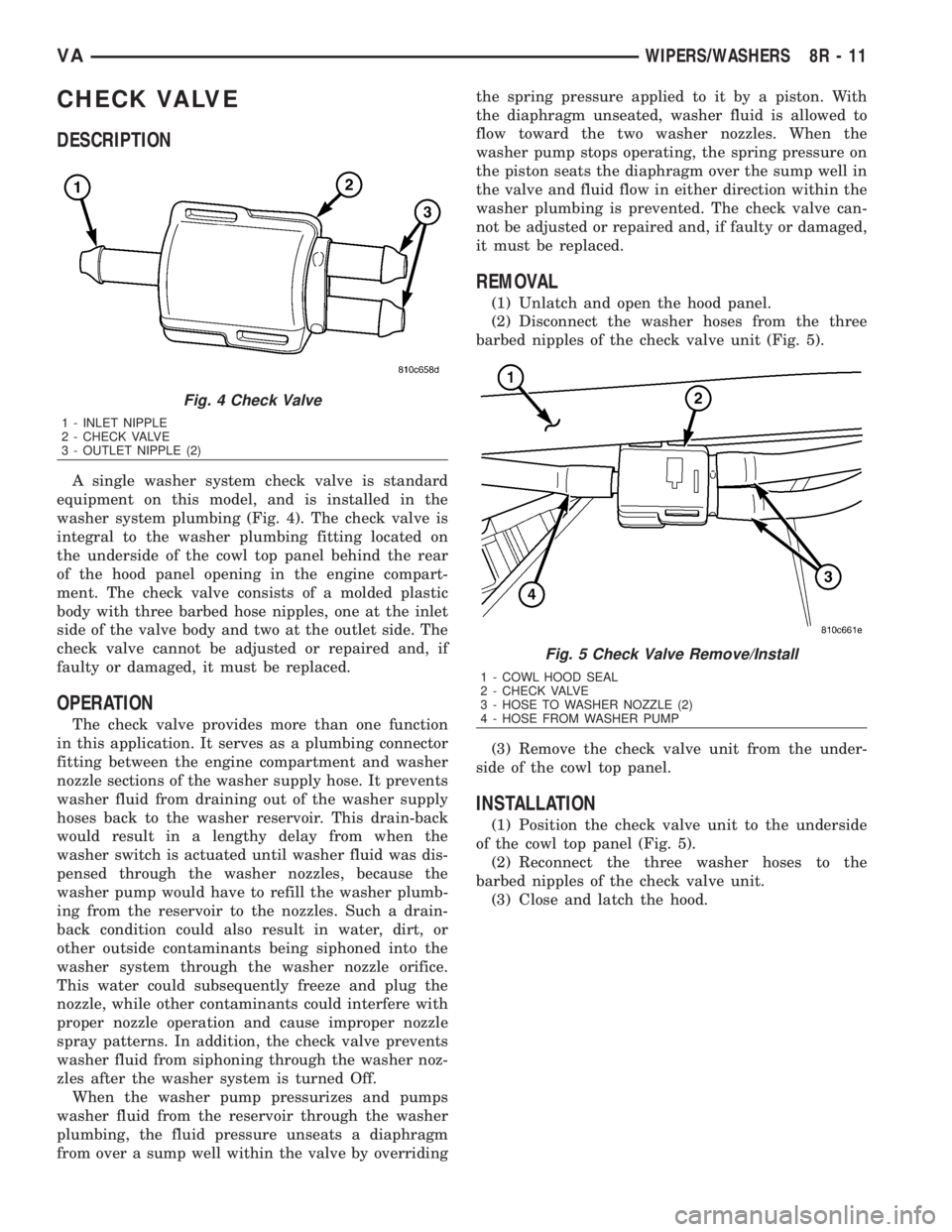
CHECK VALVE
DESCRIPTION
A single washer system check valve is standard
equipment on this model, and is installed in the
washer system plumbing (Fig. 4). The check valve is
integral to the washer plumbing fitting located on
the underside of the cowl top panel behind the rear
of the hood panel opening in the engine compart-
ment. The check valve consists of a molded plastic
body with three barbed hose nipples, one at the inlet
side of the valve body and two at the outlet side. The
check valve cannot be adjusted or repaired and, if
faulty or damaged, it must be replaced.
OPERATION
The check valve provides more than one function
in this application. It serves as a plumbing connector
fitting between the engine compartment and washer
nozzle sections of the washer supply hose. It prevents
washer fluid from draining out of the washer supply
hoses back to the washer reservoir. This drain-back
would result in a lengthy delay from when the
washer switch is actuated until washer fluid was dis-
pensed through the washer nozzles, because the
washer pump would have to refill the washer plumb-
ing from the reservoir to the nozzles. Such a drain-
back condition could also result in water, dirt, or
other outside contaminants being siphoned into the
washer system through the washer nozzle orifice.
This water could subsequently freeze and plug the
nozzle, while other contaminants could interfere with
proper nozzle operation and cause improper nozzle
spray patterns. In addition, the check valve prevents
washer fluid from siphoning through the washer noz-
zles after the washer system is turned Off.
When the washer pump pressurizes and pumps
washer fluid from the reservoir through the washer
plumbing, the fluid pressure unseats a diaphragm
from over a sump well within the valve by overridingthe spring pressure applied to it by a piston. With
the diaphragm unseated, washer fluid is allowed to
flow toward the two washer nozzles. When the
washer pump stops operating, the spring pressure on
the piston seats the diaphragm over the sump well in
the valve and fluid flow in either direction within the
washer plumbing is prevented. The check valve can-
not be adjusted or repaired and, if faulty or damaged,
it must be replaced.
REMOVAL
(1) Unlatch and open the hood panel.
(2) Disconnect the washer hoses from the three
barbed nipples of the check valve unit (Fig. 5).
(3) Remove the check valve unit from the under-
side of the cowl top panel.
INSTALLATION
(1) Position the check valve unit to the underside
of the cowl top panel (Fig. 5).
(2) Reconnect the three washer hoses to the
barbed nipples of the check valve unit.
(3) Close and latch the hood.
Fig. 4 Check Valve
1 - INLET NIPPLE
2 - CHECK VALVE
3 - OUTLET NIPPLE (2)
Fig. 5 Check Valve Remove/Install
1 - COWL HOOD SEAL
2 - CHECK VALVE
3 - HOSE TO WASHER NOZZLE (2)
4 - HOSE FROM WASHER PUMP
VAWIPERS/WASHERS 8R - 11
Page 1055 of 2305
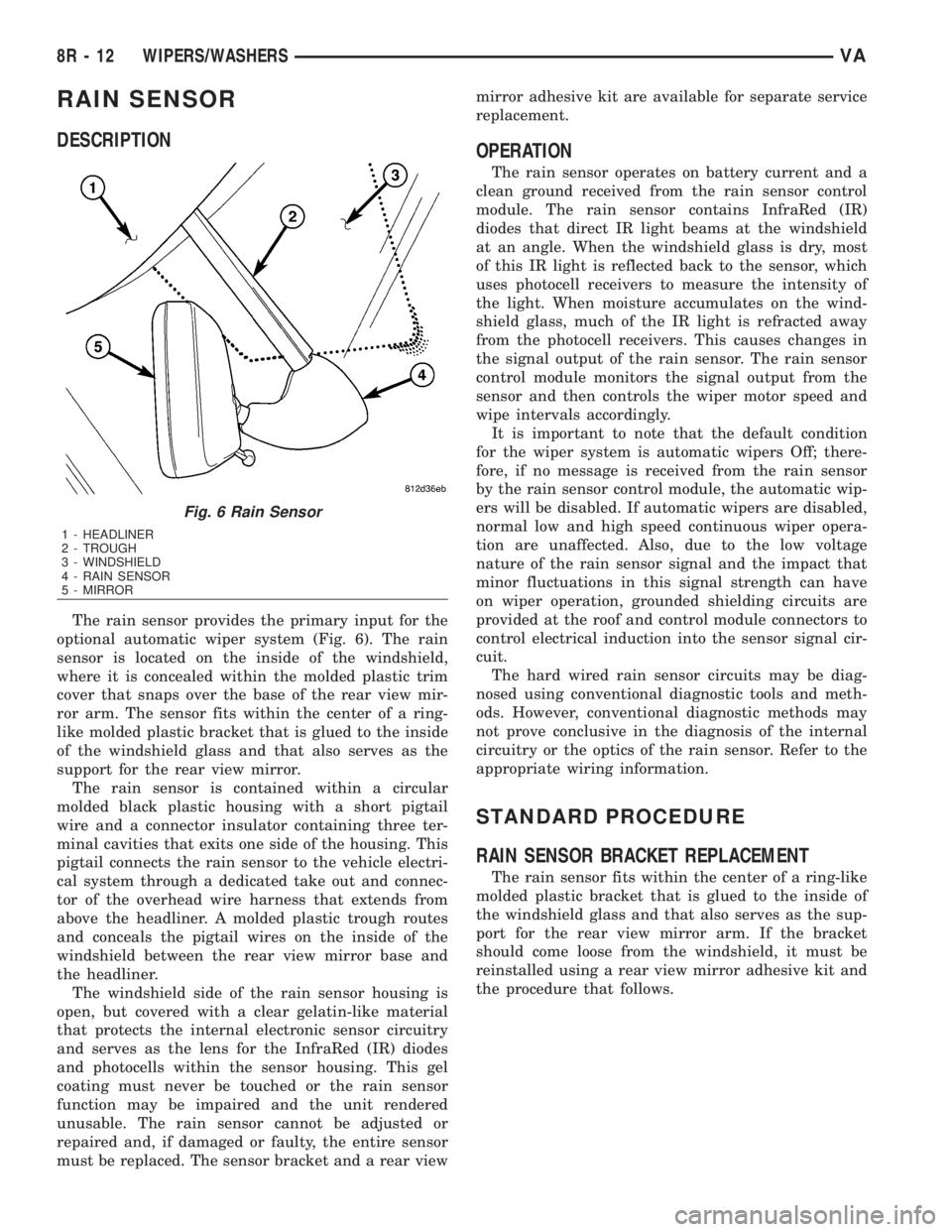
RAIN SENSOR
DESCRIPTION
The rain sensor provides the primary input for the
optional automatic wiper system (Fig. 6). The rain
sensor is located on the inside of the windshield,
where it is concealed within the molded plastic trim
cover that snaps over the base of the rear view mir-
ror arm. The sensor fits within the center of a ring-
like molded plastic bracket that is glued to the inside
of the windshield glass and that also serves as the
support for the rear view mirror.
The rain sensor is contained within a circular
molded black plastic housing with a short pigtail
wire and a connector insulator containing three ter-
minal cavities that exits one side of the housing. This
pigtail connects the rain sensor to the vehicle electri-
cal system through a dedicated take out and connec-
tor of the overhead wire harness that extends from
above the headliner. A molded plastic trough routes
and conceals the pigtail wires on the inside of the
windshield between the rear view mirror base and
the headliner.
The windshield side of the rain sensor housing is
open, but covered with a clear gelatin-like material
that protects the internal electronic sensor circuitry
and serves as the lens for the InfraRed (IR) diodes
and photocells within the sensor housing. This gel
coating must never be touched or the rain sensor
function may be impaired and the unit rendered
unusable. The rain sensor cannot be adjusted or
repaired and, if damaged or faulty, the entire sensor
must be replaced. The sensor bracket and a rear viewmirror adhesive kit are available for separate service
replacement.
OPERATION
The rain sensor operates on battery current and a
clean ground received from the rain sensor control
module. The rain sensor contains InfraRed (IR)
diodes that direct IR light beams at the windshield
at an angle. When the windshield glass is dry, most
of this IR light is reflected back to the sensor, which
uses photocell receivers to measure the intensity of
the light. When moisture accumulates on the wind-
shield glass, much of the IR light is refracted away
from the photocell receivers. This causes changes in
the signal output of the rain sensor. The rain sensor
control module monitors the signal output from the
sensor and then controls the wiper motor speed and
wipe intervals accordingly.
It is important to note that the default condition
for the wiper system is automatic wipers Off; there-
fore, if no message is received from the rain sensor
by the rain sensor control module, the automatic wip-
ers will be disabled. If automatic wipers are disabled,
normal low and high speed continuous wiper opera-
tion are unaffected. Also, due to the low voltage
nature of the rain sensor signal and the impact that
minor fluctuations in this signal strength can have
on wiper operation, grounded shielding circuits are
provided at the roof and control module connectors to
control electrical induction into the sensor signal cir-
cuit.
The hard wired rain sensor circuits may be diag-
nosed using conventional diagnostic tools and meth-
ods. However, conventional diagnostic methods may
not prove conclusive in the diagnosis of the internal
circuitry or the optics of the rain sensor. Refer to the
appropriate wiring information.
STANDARD PROCEDURE
RAIN SENSOR BRACKET REPLACEMENT
The rain sensor fits within the center of a ring-like
molded plastic bracket that is glued to the inside of
the windshield glass and that also serves as the sup-
port for the rear view mirror arm. If the bracket
should come loose from the windshield, it must be
reinstalled using a rear view mirror adhesive kit and
the procedure that follows.
Fig. 6 Rain Sensor
1 - HEADLINER
2 - TROUGH
3 - WINDSHIELD
4 - RAIN SENSOR
5 - MIRROR
8R - 12 WIPERS/WASHERSVA
Page 1058 of 2305
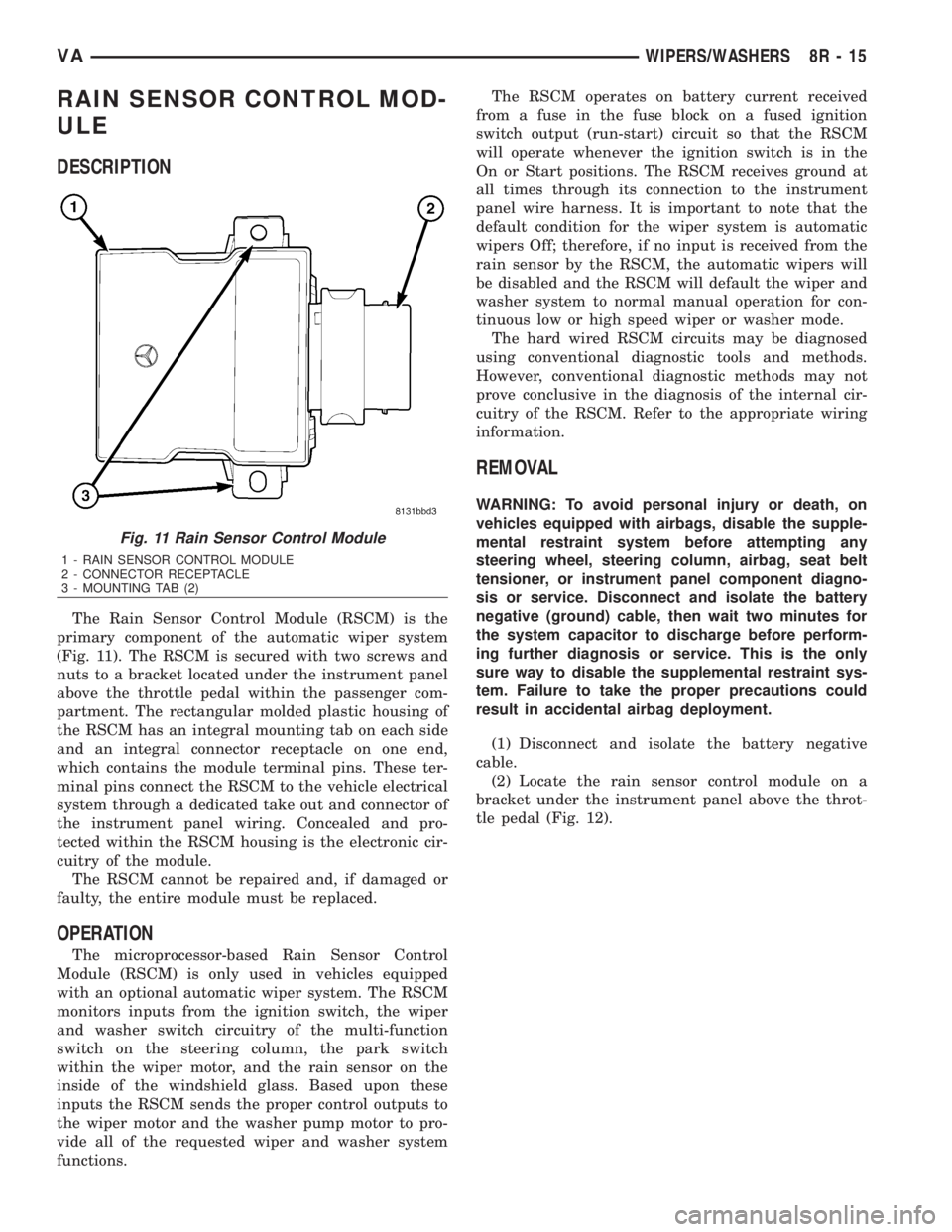
RAIN SENSOR CONTROL MOD-
ULE
DESCRIPTION
The Rain Sensor Control Module (RSCM) is the
primary component of the automatic wiper system
(Fig. 11). The RSCM is secured with two screws and
nuts to a bracket located under the instrument panel
above the throttle pedal within the passenger com-
partment. The rectangular molded plastic housing of
the RSCM has an integral mounting tab on each side
and an integral connector receptacle on one end,
which contains the module terminal pins. These ter-
minal pins connect the RSCM to the vehicle electrical
system through a dedicated take out and connector of
the instrument panel wiring. Concealed and pro-
tected within the RSCM housing is the electronic cir-
cuitry of the module.
The RSCM cannot be repaired and, if damaged or
faulty, the entire module must be replaced.
OPERATION
The microprocessor-based Rain Sensor Control
Module (RSCM) is only used in vehicles equipped
with an optional automatic wiper system. The RSCM
monitors inputs from the ignition switch, the wiper
and washer switch circuitry of the multi-function
switch on the steering column, the park switch
within the wiper motor, and the rain sensor on the
inside of the windshield glass. Based upon these
inputs the RSCM sends the proper control outputs to
the wiper motor and the washer pump motor to pro-
vide all of the requested wiper and washer system
functions.The RSCM operates on battery current received
from a fuse in the fuse block on a fused ignition
switch output (run-start) circuit so that the RSCM
will operate whenever the ignition switch is in the
On or Start positions. The RSCM receives ground at
all times through its connection to the instrument
panel wire harness. It is important to note that the
default condition for the wiper system is automatic
wipers Off; therefore, if no input is received from the
rain sensor by the RSCM, the automatic wipers will
be disabled and the RSCM will default the wiper and
washer system to normal manual operation for con-
tinuous low or high speed wiper or washer mode.
The hard wired RSCM circuits may be diagnosed
using conventional diagnostic tools and methods.
However, conventional diagnostic methods may not
prove conclusive in the diagnosis of the internal cir-
cuitry of the RSCM. Refer to the appropriate wiring
information.
REMOVAL
WARNING: To avoid personal injury or death, on
vehicles equipped with airbags, disable the supple-
mental restraint system before attempting any
steering wheel, steering column, airbag, seat belt
tensioner, or instrument panel component diagno-
sis or service. Disconnect and isolate the battery
negative (ground) cable, then wait two minutes for
the system capacitor to discharge before perform-
ing further diagnosis or service. This is the only
sure way to disable the supplemental restraint sys-
tem. Failure to take the proper precautions could
result in accidental airbag deployment.
(1) Disconnect and isolate the battery negative
cable.
(2) Locate the rain sensor control module on a
bracket under the instrument panel above the throt-
tle pedal (Fig. 12).
Fig. 11 Rain Sensor Control Module
1 - RAIN SENSOR CONTROL MODULE
2 - CONNECTOR RECEPTACLE
3 - MOUNTING TAB (2)
VAWIPERS/WASHERS 8R - 15
Page 1080 of 2305
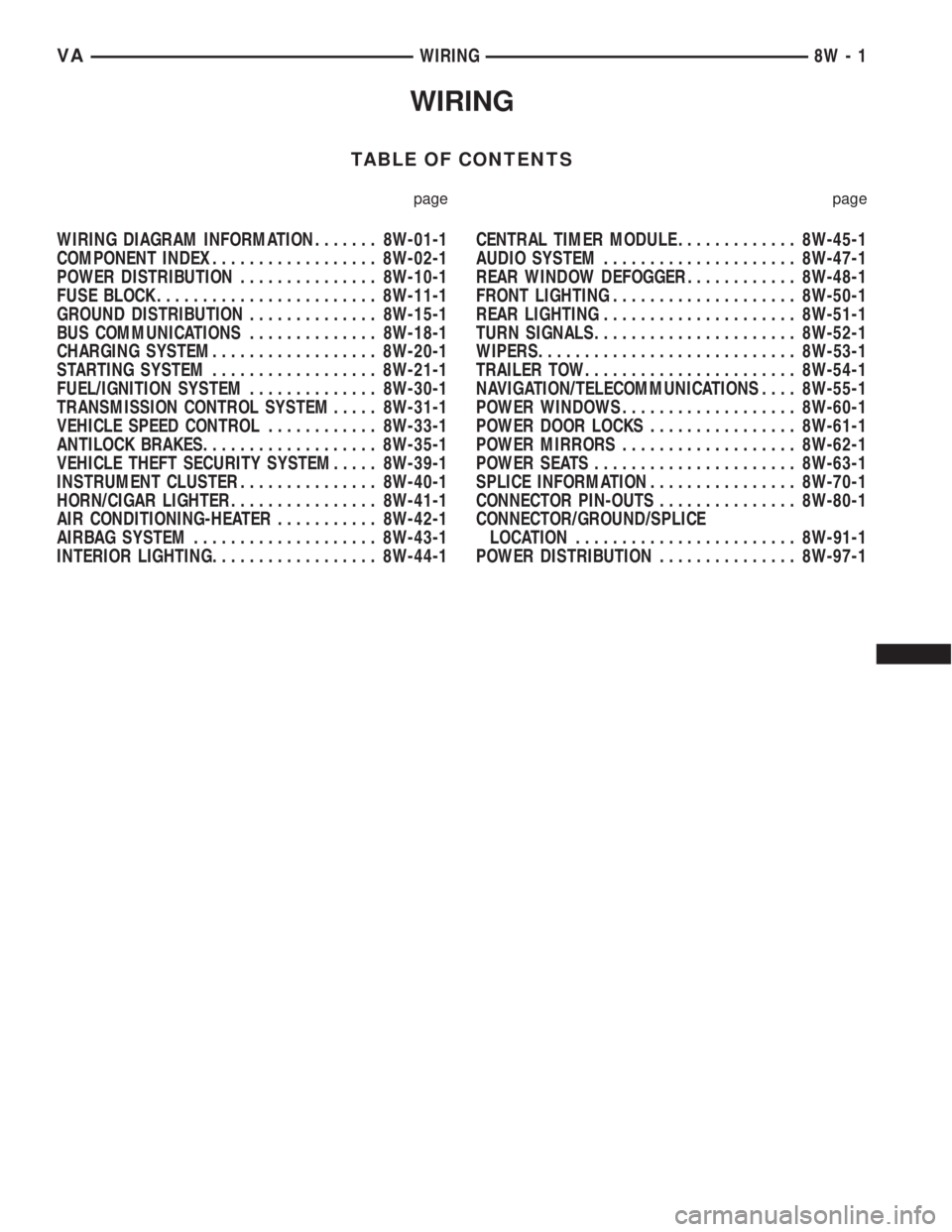
WIRING
TABLE OF CONTENTS
page page
WIRING DIAGRAM INFORMATION....... 8W-01-1
COMPONENT INDEX.................. 8W-02-1
POWER DISTRIBUTION............... 8W-10-1
FUSE BLOCK........................ 8W-11-1
GROUND DISTRIBUTION.............. 8W-15-1
BUS COMMUNICATIONS.............. 8W-18-1
CHARGING SYSTEM.................. 8W-20-1
STARTING SYSTEM.................. 8W-21-1
FUEL/IGNITION SYSTEM.............. 8W-30-1
TRANSMISSION CONTROL SYSTEM..... 8W-31-1
VEHICLE SPEED CONTROL............ 8W-33-1
ANTILOCK BRAKES................... 8W-35-1
VEHICLE THEFT SECURITY SYSTEM..... 8W-39-1
INSTRUMENT CLUSTER............... 8W-40-1
HORN/CIGAR LIGHTER................ 8W-41-1
AIR CONDITIONING-HEATER........... 8W-42-1
AIRBAG SYSTEM.................... 8W-43-1
INTERIOR LIGHTING.................. 8W-44-1CENTRAL TIMER MODULE............. 8W-45-1
AUDIO SYSTEM..................... 8W-47-1
REAR WINDOW DEFOGGER............ 8W-48-1
FRONT LIGHTING.................... 8W-50-1
REAR LIGHTING..................... 8W-51-1
TURN SIGNALS...................... 8W-52-1
WIPERS............................ 8W-53-1
TRAILER TOW....................... 8W-54-1
NAVIGATION/TELECOMMUNICATIONS.... 8W-55-1
POWER WINDOWS................... 8W-60-1
POWER DOOR LOCKS................ 8W-61-1
POWER MIRRORS................... 8W-62-1
POWER SEATS...................... 8W-63-1
SPLICE INFORMATION................ 8W-70-1
CONNECTOR PIN-OUTS............... 8W-80-1
CONNECTOR/GROUND/SPLICE
LOCATION........................ 8W-91-1
POWER DISTRIBUTION............... 8W-97-1 VAWIRING 8W - 1
Page 1290 of 2305
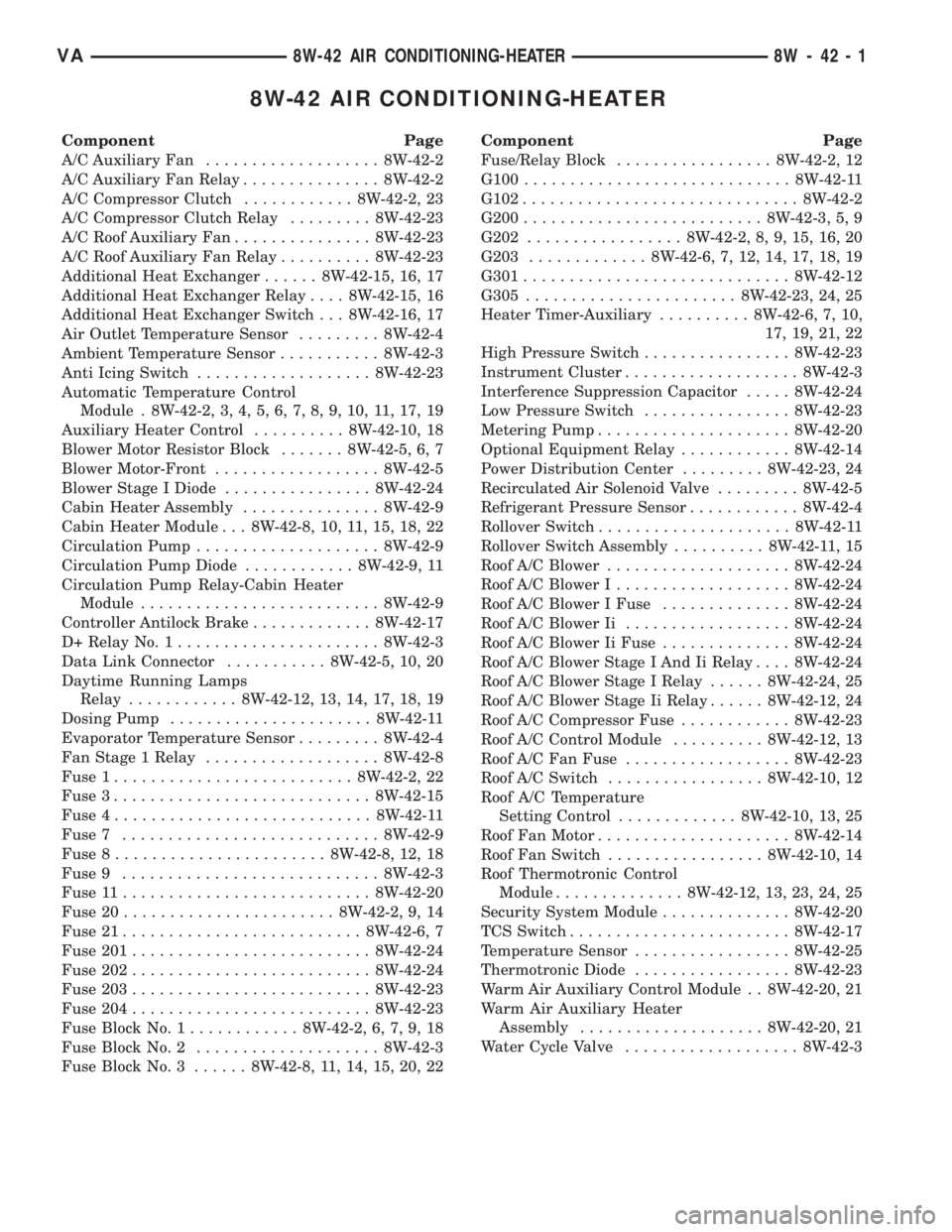
8W-42 AIR CONDITIONING-HEATER
Component Page
A/C Auxiliary Fan................... 8W-42-2
A/C Auxiliary Fan Relay............... 8W-42-2
A/C Compressor Clutch............ 8W-42-2, 23
A/C Compressor Clutch Relay......... 8W-42-23
A/C Roof Auxiliary Fan............... 8W-42-23
A/C Roof Auxiliary Fan Relay.......... 8W-42-23
Additional Heat Exchanger...... 8W-42-15, 16, 17
Additional Heat Exchanger Relay.... 8W-42-15, 16
Additional Heat Exchanger Switch . . . 8W-42-16, 17
Air Outlet Temperature Sensor......... 8W-42-4
Ambient Temperature Sensor........... 8W-42-3
Anti Icing Switch................... 8W-42-23
Automatic Temperature Control
Module . 8W-42-2, 3, 4, 5, 6, 7, 8, 9, 10, 11, 17, 19
Auxiliary Heater Control.......... 8W-42-10, 18
Blower Motor Resistor Block....... 8W-42-5, 6, 7
Blower Motor-Front.................. 8W-42-5
Blower Stage I Diode................ 8W-42-24
Cabin Heater Assembly............... 8W-42-9
Cabin Heater Module . . . 8W-42-8, 10, 11, 15, 18, 22
Circulation Pump.................... 8W-42-9
Circulation Pump Diode............ 8W-42-9, 11
Circulation Pump Relay-Cabin Heater
Module.......................... 8W-42-9
Controller Antilock Brake............. 8W-42-17
D+ Relay No. 1...................... 8W-42-3
Data Link Connector........... 8W-42-5, 10, 20
Daytime Running Lamps
Relay............ 8W-42-12, 13, 14, 17, 18, 19
Dosing Pump...................... 8W-42-11
Evaporator Temperature Sensor......... 8W-42-4
Fan Stage 1 Relay................... 8W-42-8
Fuse 1.......................... 8W-42-2, 22
Fuse 3............................ 8W-42-15
Fuse 4............................ 8W-42-11
Fuse 7............................ 8W-42-9
Fuse 8....................... 8W-42-8, 12, 18
Fuse 9............................ 8W-42-3
Fuse 11........................... 8W-42-20
Fuse 20....................... 8W-42-2, 9, 14
Fuse 21.......................... 8W-42-6, 7
Fuse 201.......................... 8W-42-24
Fuse 202.......................... 8W-42-24
Fuse 203.......................... 8W-42-23
Fuse 204.......................... 8W-42-23
Fuse Block No. 1............ 8W-42-2, 6, 7, 9, 18
Fuse Block No. 2.................... 8W-42-3
Fuse Block No. 3...... 8W-42-8, 11, 14, 15, 20, 22Component Page
Fuse/Relay Block................. 8W-42-2, 12
G100............................. 8W-42-11
G102.............................. 8W-42-2
G200.......................... 8W-42-3, 5, 9
G202................. 8W-42-2, 8, 9, 15, 16, 20
G203............. 8W-42-6, 7, 12, 14, 17, 18, 19
G301............................. 8W-42-12
G305....................... 8W-42-23, 24, 25
Heater Timer-Auxiliary.......... 8W-42-6, 7, 10,
17, 19, 21, 22
High Pressure Switch................ 8W-42-23
Instrument Cluster................... 8W-42-3
Interference Suppression Capacitor..... 8W-42-24
Low Pressure Switch................ 8W-42-23
Metering Pump..................... 8W-42-20
Optional Equipment Relay............ 8W-42-14
Power Distribution Center......... 8W-42-23, 24
Recirculated Air Solenoid Valve......... 8W-42-5
Refrigerant Pressure Sensor............ 8W-42-4
Rollover Switch..................... 8W-42-11
Rollover Switch Assembly.......... 8W-42-11, 15
Roof A/C Blower.................... 8W-42-24
Roof A/C Blower I................... 8W-42-24
Roof A/C Blower I Fuse.............. 8W-42-24
Roof A/C Blower Ii.................. 8W-42-24
Roof A/C Blower Ii Fuse.............. 8W-42-24
Roof A/C Blower Stage I And Ii Relay.... 8W-42-24
Roof A/C Blower Stage I Relay...... 8W-42-24, 25
Roof A/C Blower Stage Ii Relay...... 8W-42-12, 24
Roof A/C Compressor Fuse............ 8W-42-23
Roof A/C Control Module.......... 8W-42-12, 13
Roof A/C Fan Fuse.................. 8W-42-23
Roof A/C Switch................. 8W-42-10, 12
Roof A/C Temperature
Setting Control............. 8W-42-10, 13, 25
Roof Fan Motor..................... 8W-42-14
Roof Fan Switch................. 8W-42-10, 14
Roof Thermotronic Control
Module.............. 8W-42-12, 13, 23, 24, 25
Security System Module.............. 8W-42-20
TCS Switch........................ 8W-42-17
Temperature Sensor................. 8W-42-25
Thermotronic Diode................. 8W-42-23
Warm Air Auxiliary Control Module . . 8W-42-20, 21
Warm Air Auxiliary Heater
Assembly.................... 8W-42-20, 21
Water Cycle Valve................... 8W-42-3
VA8W-42 AIR CONDITIONING-HEATER 8W - 42 - 1